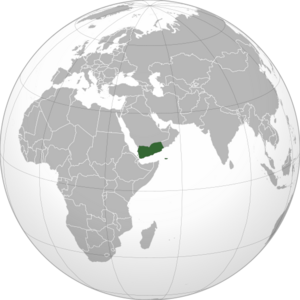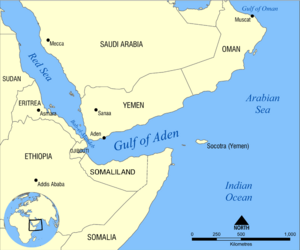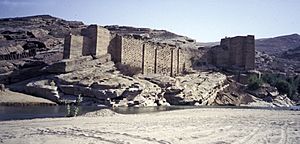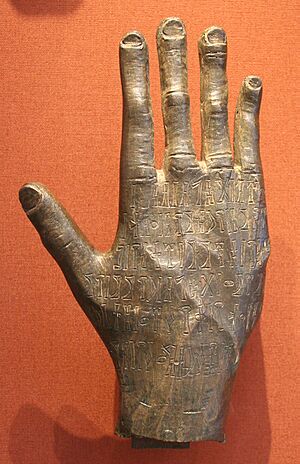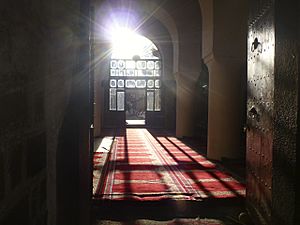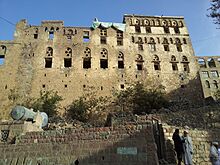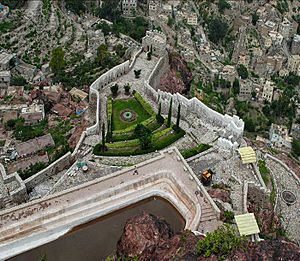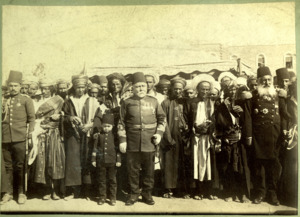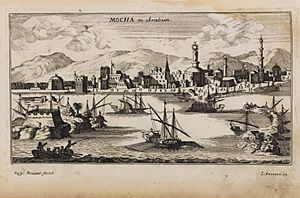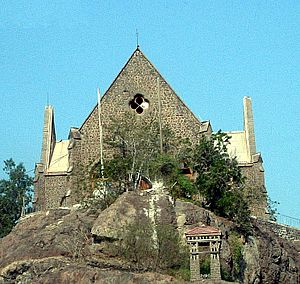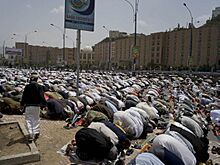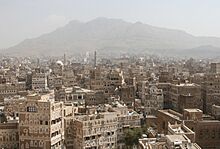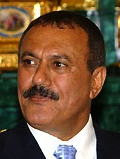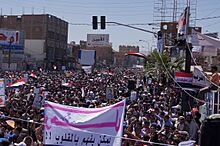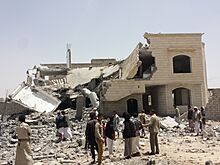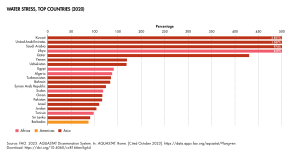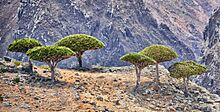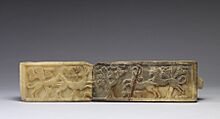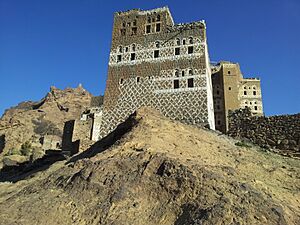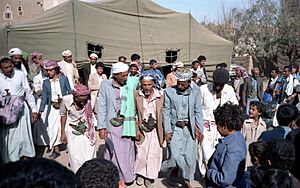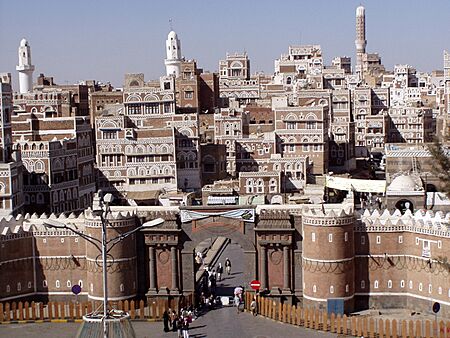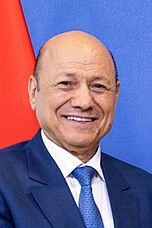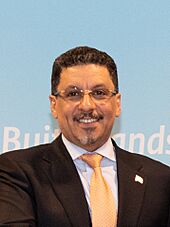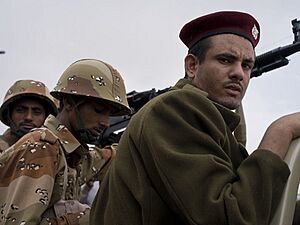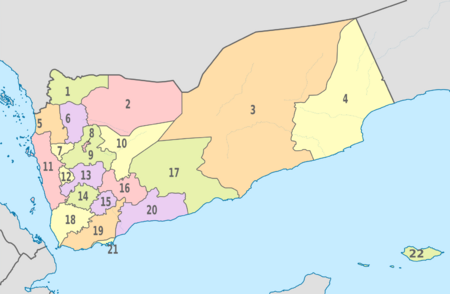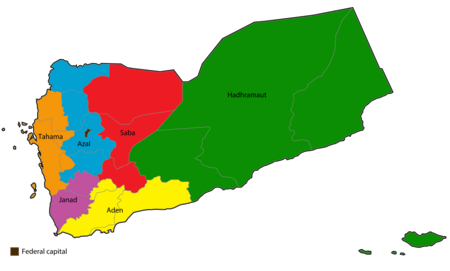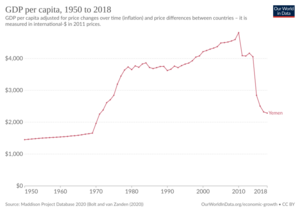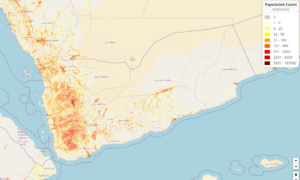Yemen facts for kids
Quick facts for kids
Republic of Yemen
|
|
|---|---|
|
Motto: ٱللَّهُ، ٱلْوَطَنُ، ٱلْثَوْرَةُ، ٱلْوَحْدَةُ
Allāh, al-Waṭan, ath-Thawrah, al-Waḥdah "God, the Homeland, Revolution, Unity" |
|
|
Anthem: الجمهورية المتحدة
al-Jumhūriyyah al-Muttaḥidah "United Republic" |
|
| Capital and largest city
|
Sanaa |
| Government seat | Aden |
| Official language and national language |
Arabic |
| Ethnic groups
(2000)
|
92.8% Arabs 3.7% Somalis 3.5% other |
| Religion
(2020), also see Religion in Yemen
|
|
| Demonym(s) | Yemeni Yemenite |
| Government | Unitary provisional republic |
|
• Chairman of the Presidential Leadership Council
|
Rashad al-Alimi |
| Salem Saleh bin Braik | |
|
• President of the House of Representatives
|
Sultan al-Barakani |
| Legislature | Parliament |
| Shura Council | |
| House of Representatives | |
| Establishment | |
|
• Unification
|
22 May 1990 |
|
• Current constitution
|
16 May 1991 |
| Area | |
|
• Total
|
455,503 km2 (175,871 sq mi) (54th) |
|
• Water (%)
|
negligible |
| Population | |
|
• 2023 estimate
|
32,684,503 |
|
• Density
|
71.8/km2 (186.0/sq mi) (143rd) |
| GDP (PPP) | 2023 estimate |
|
• Total
|
|
|
• Per capita
|
|
| GDP (nominal) | 2023 estimate |
|
• Total
|
|
|
• Per capita
|
|
| Gini (2014) | 36.7 medium |
| HDI (2023) | low · 184th |
| Currency | Yemeni rial (YER) |
| Time zone | UTC+3 (AST) |
| Driving side | right |
| Calling code | +967 |
| ISO 3166 code | YE |
| Internet TLD | .ye, اليمن. |
Yemen, officially the Republic of Yemen, is a country in West Asia. It is located in the southern part of the Arabian Peninsula. Yemen shares borders with Saudi Arabia to the north and Oman to the northeast. Its coastline touches the Arabian Sea in the east, the Gulf of Aden in the south, and the Red Sea in the west. Yemen also has sea borders with Djibouti, Eritrea, and Somalia.
Yemen covers about 455,503 square kilometers (175,871 square miles). This makes it the second-largest country on the Arabian Peninsula. Sanaa is its capital and largest city. Yemen's population is estimated to be around 34.7 million people, mostly Arab Muslims. Yemen is a member of important international groups like the Arab League and the United Nations.
For over 7,000 years, Yemen has been a meeting point for many civilizations due to its location. Ancient kingdoms like the Sabaeans and Himyarite Kingdom thrived here. Islam spread quickly in the seventh century, making Yemen a center for Islamic learning. For centuries, Yemen was famous for producing coffee, which was shipped from the port of Mocha.
In the 19th century, the country was divided between the Ottoman and British empires. After World War I, the Kingdom of Yemen was formed. This later became the Yemen Arab Republic (North Yemen) in 1962. In 1967, the British-controlled south became the independent People's Democratic Republic of Yemen (South Yemen). In 1990, North and South Yemen united to form the modern Republic of Yemen.
Since 2011, Yemen has faced a difficult political crisis. This started with protests against poverty and unemployment. By 2015, the country was in a civil war. This conflict involves different groups trying to control the country. Many foreign powers have also become involved. This has led to a very serious humanitarian crisis.
Yemen is one of the poorest countries in the world. It faces big challenges in sustainable development. In 2019, the United Nations reported that about 24 million people, or nearly 75% of Yemen's population, needed humanitarian aid. As of 2024, Yemen is considered the world's least peaceful country. It also has the lowest Human Development Index outside of Africa. Yemen is very vulnerable to climate change and not well prepared for its effects.
Contents
Understanding the Name of Yemen
The name Yamnat was first seen in old inscriptions from the second Himyarite Kingdom. It likely referred to the southwestern coast of the Arabian Peninsula. Historically, Yemen was much larger than it is today. It stretched from parts of Saudi Arabia to Oman.
One idea is that Yemen comes from ymnt, meaning "South [of the Arabian Peninsula]". Another idea is that it comes from yamn or yumn, meaning "happiness" or "blessed". This is because much of Yemen is fertile, unlike most of Arabia. The Romans even called it Arabia Felix ("happy Arabia").
Yemen's Long History
Ancient Times
Yemen's location made it a key trading spot between eastern and western civilizations. Large settlements existed in Yemen's mountains as early as 5000 BC. The Sabaean Kingdom began around the 12th century BC. They were one of four major kingdoms in South Arabia.
The Sabaeans were very important. Their rulers were called Mukarrib, meaning "unifier" or "priest-king". They built the Great Dam of Marib around 940 BC. This dam helped control seasonal floods.
By the third century BC, other kingdoms became independent from Saba. The Sabaeans later regained control over some areas. In 25 BC, the Romans tried to conquer the Sabaeans but failed.
After the Roman attempt, the country faced problems. Two groups, Hamdan and Himyar, fought for control. The Himyarites eventually unified Yemen by 275 AD. They followed a form of monotheism called Rahmanism.
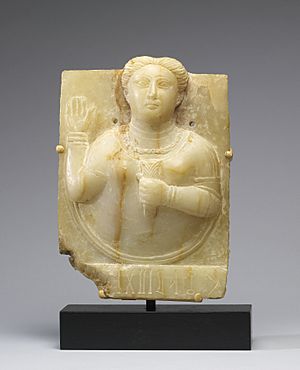
In 354 AD, the Roman Emperor sent a group to try and convert the Himyarites to Christianity. However, local Jewish communities resisted this. Inscriptions have been found praising the Jewish ruling family.
Around 515 AD, Himyar became divided by religion. This led to an invasion by the Aksumite kingdom from Ethiopia. The last Himyarite king was Christian. After his death, a Jewish leader named Dhu Nuwas took power. The Sasanid Empire (Persia) later took control of Aden around 570 AD. This period marked the end of ancient South Arabian civilization.
Middle Ages
The Arrival of Islam
Muhammad sent his cousin Ali to Sana'a around 630 AD. At that time, Yemen was a very advanced region in Arabia. Many Yemeni tribes quickly accepted Islam. Yemeni soldiers played a big role in the early Islamic conquests across different regions.
Yemen remained stable during the early Islamic rule. Yemeni tribes helped strengthen the Umayyad Caliphate. Later, different local dynasties emerged, like the Ziyadids in the coastal areas and the Yufirids in the highlands.
The first Zaidi imam, Yahya ibn al-Husayn, arrived in Yemen in 893 AD. He was a religious leader invited to settle tribal disputes. He founded the Zaidi imamate in 897 AD, and his teachings spread in the highlands.
Sulayhid Rule (1047–1138)
The Sulayhid dynasty was founded around 1040. By 1063, they had conquered much of Yemen. Ali ibn Muhammad Al-Sulayhi even took Makkah. His wife, Asma bint Shihab, governed Yemen with him, which was very unusual for an Arab woman at that time.
After Ali's death, his wife Arwa al-Sulayhi took over. She moved the capital to Jibla. Queen Arwa is remembered as a great and beloved ruler in Yemen. After her death in 1138, the country split into smaller states.
Ayyubid Conquest (1171–1260)
The Ayyubid dynasty from Egypt conquered Yemen starting in 1174. They controlled southern and central Yemen. However, they struggled to control the Zaidi strongholds in the north. The Zaydis continued to fight against Ayyubid rule.
Rasulid Dynasty (1229–1454)
The Rasulid dynasty began in 1229. They made Zabid and Taiz their capitals. The Rasulid rulers were educated and built many schools to promote Islamic learning. Taiz and Zabid became important centers for knowledge.

The Rasulids faced challenges from Egypt and from local tribal revolts. Their power weakened, allowing the Banu Taher clan to take over in 1454.
Tahirid Dynasty (1454–1517)
The Tahirids built schools, mosques, and irrigation systems. Their most famous building is the Amiriya Madrasa in Rada' District, built in 1504. However, they were not strong enough to defend Yemen from outside attacks.
The Mamluks from Egypt tried to conquer Yemen. The Portuguese also became a threat, occupying the island of Socotra for a time.
Modern History
Zaydis and Ottomans
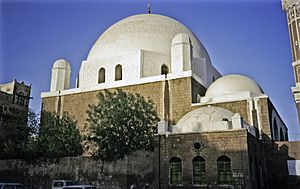
The Ottoman Empire wanted to control Yemen to protect Islamic holy cities and trade routes. They conquered parts of Yemen starting in 1538. The Ottomans mainly controlled the coastal areas. They struggled to control the highlands, where the Zaydi tribes resisted fiercely.
The Zaydi leader, Imam al-Mutahhar ibn Yahya, led a strong rebellion against the Ottomans. By 1568, most of Yemen was free from Ottoman control, except for Zabid.
In the 17th century, Yemen became the world's only producer of coffee. This brought wealth and led to diplomatic ties with other empires. However, European countries later started growing coffee elsewhere, ending Yemen's monopoly. Internal conflicts also weakened the Yemeni imamate.
British Influence
The British Empire became interested in Aden as a coal refueling station for ships going to India. They occupied Aden in 1839. Aden grew into a major global city with people from many different places. The British presence in Aden caused tension with the Ottomans, who claimed control over all of Arabia.
Ottoman Return
The Ottomans returned to Yemen in 1849, worried about British expansion. They tried to bring order to the country and control the highlands. However, the Zaydi tribes continued to rebel. The Ottomans signed a treaty with Imam Yahya Hamidaddin in 1911. This treaty recognized Imam Yahya as an independent leader of the northern highlands. The Ottomans left Yemen completely in 1918.
Mutawakkilite Kingdom
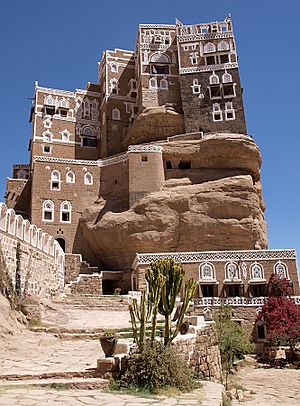
Imam Yahya Hamidaddin ruled the northern highlands from 1911. He began to expand his control over other Yemeni lands. In 1925, he captured Al Hudaydah. He also signed treaties with Italy and Britain, recognizing his rule over parts of Yemen. A war with Saudi Arabia in 1934 led to Yemen giving up some northern territories.
Colonial Aden
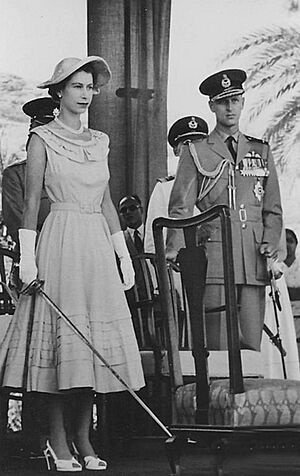
Many Yemenis moved to Aden for work in the late 1800s, making it mostly Arab again. During World War II, Aden became a very busy port. People in Aden began to resist British rule, forming labor unions and political groups.
The British divided their controlled areas in the south into many small states. They created the Federation of South Arabia to try and manage the growing desire for independence.
Two Separate States
In 1962, a civil war broke out in North Yemen after the Imam died. The royalists were supported by Saudi Arabia and Britain, while the rebels were backed by Egypt. After six years, the rebels formed the Yemen Arab Republic (North Yemen).
In 1967, the British left the south, and the People's Democratic Republic of Yemen (South Yemen) was formed. This was the first and only socialist state in the Arab world.

Relations between North and South Yemen were sometimes peaceful, sometimes hostile. They fought a war in 1972, agreeing to unite later. In 1978, Ali Abdullah Saleh became president of North Yemen. Another conflict in 1979 renewed efforts for unification. A civil war in South Yemen in 1986 also led to changes in its government.
Unification and Civil War
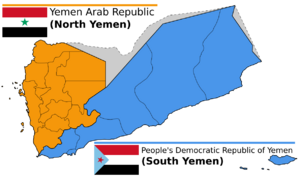
On May 22, 1990, the two Yemeni states officially united to form the modern Republic of Yemen. Ali Abdullah Saleh became the first president, and the president of South Yemen became vice president. A new parliament and constitution were created.
When Iraq invaded Kuwait in 1990, Yemen's president opposed military action by non-Arab countries. This angered the U.S. and Saudi Arabia. Saudi Arabia expelled many Yemenis as a result.

After unification, different groups in Yemen, including tribes and political parties, tried to share power. However, tensions grew between the north and south. In 1993, the vice president from the south withdrew from the government, complaining about violence and economic problems. Despite an agreement in 1994, a civil war broke out between northern and southern forces.
Yemen Today
Ali Abdullah Saleh was elected president in 1999 and again in 2006. In 2000, a terrorist attack on the U.S. naval ship USS Cole in Aden killed 17 U.S. personnel. After the September 11 attacks, President Saleh promised to help the U.S. fight terrorism.
The Houthi insurgency in Yemen began in 2004. This group, from the Zaidi Shia sect, started an uprising against the government. They claimed they were fighting discrimination.
The 2011 Yemeni revolution was part of the Arab Spring protests. People protested against unemployment, corruption, and the president's plan to stay in power longer. In November 2011, President Saleh agreed to step down and transfer power to his deputy, Abdrabbuh Mansur Hadi.
Hadi became president in 2012. However, the central government remained weak. The Houthi insurgency grew stronger. In September 2014, Houthi forces took over the capital, Sana'a. They forced Hadi to agree to a "unity" government. In January 2015, the Houthis dissolved parliament and declared their own ruling committee.
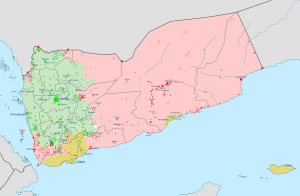
Controlled by the Government of Yemen (under the Presidential Leadership Council since April 2022) and allies Controlled by Houthis-led Supreme Political Council Controlled by the UAE-backed Southern Transitional Council Controlled by Al-Qaeda (AQAP) and Islamic State of Iraq and the Levant-affiliated Ansar al-Sharia Controlled by Hadrami Elite Forces. Controlled by Tareq Saleh's National Resistance Forces
President Hadi fled to Aden in February 2015. He declared Aden the temporary capital. The Houthis continued to advance south. On March 26, 2015, Saudi Arabia and its allies began airstrikes against the Houthis. This started a large-scale military intervention.
Yemen has been suffering from a severe famine since 2016 due to the civil war. Many children have died from starvation. There has also been a widespread cholera outbreak. The conflict and blockades have made the humanitarian crisis much worse. By the end of 2021, the war had caused over 377,000 deaths, with about 70% of those being children under five.
In December 2017, former president Ali Abdullah Saleh was killed by Houthis. In April 2022, President Hadi resigned, and the Presidential Leadership Council took power. In June 2024, there were discussions about leasing the Port of Aden to a company from Abu Dhabi. This move was opposed by many in Yemen who feared it would harm the port's importance.
Yemen's Geography
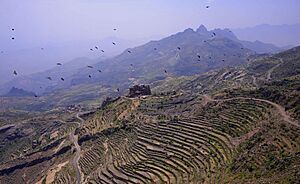
Yemen covers about 455,000 square kilometers. It is located in the southern part of the Arabian Peninsula. It borders Saudi Arabia to the north, the Red Sea to the west, the Gulf of Aden to the south, and Oman to the east.
Several islands belong to Yemen, including the Hanish Islands, Kamaran, and Perim in the Red Sea. Socotra island, in the Arabian Sea, is also part of Yemen. Many of these islands are volcanic. Socotra is geographically closer to Africa and has unique plants and animals.
Regions and Climate
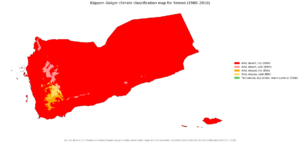
| BWh Hot desert BWk Cold desert BSh Hot semi-arid BSk Cold semi-arid CWb Subtropical highland |
Yemen has four main geographic regions:
- The coastal plains in the west, called Tihamah, are very dry and flat.
- The western highlands are heavily terraced for farming and receive the most rainfall in Arabia.
- The central highlands are a high plateau, drier than the western highlands but still good for farming with irrigation. Sana'a is in this region.
- The Rub' al Khali desert in the east is very low and receives almost no rain.
Yemen's highest point is Jabal An-Nabi Shu'ayb, at about 3,666 meters (12,028 feet). Yemen faces severe water scarcity, especially in the highlands. This is a major challenge for the country.
Biodiversity
Yemen has diverse natural environments. Its plants are a mix of tropical African and Saharo-Arabian types. Many unique plants are found in the coastal plains.
Among its animals, the Arabian leopard is very rare in the mountains. Socotra Island is especially known for its unique plants and animals, many of which are found nowhere else in the world. This includes the famous Dragon Blood Trees.
Culture in Yemen
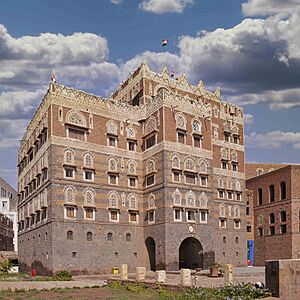
Yemen has a rich cultural heritage. Its architecture is famous for unique designs, especially the tall mud-brick buildings in cities like Shibam.
Media and Arts
Radio broadcasting in Yemen started in the 1940s. Television is the most important way people get news, especially since many people cannot read. The Yemeni film industry is still quite new.
Yemeni theatre has a long history, dating back to the early 20th century. Both amateur and professional groups perform plays. Many Yemeni writers have created dramatic works. Plays by famous international authors have also been performed in Yemen.
Sports and Activities
Football is the most popular sport in Yemen. The Yemeni national football team plays in international games. Yemen also has many football clubs.
Yemen's mountains offer great opportunities for outdoor sports like biking, rock climbing, and hiking. The coastal areas and Socotra are good for water sports like surfing and scuba diving. Socotra is known for some of the best surfing spots.
A unique traditional sport is camel jumping, popular among the Zaraniq tribe. Competitors run and leap over as many camels as they can. Yemen hosted the 20th Arabian Gulf Cup football tournament in 2010.
World Heritage Sites
Yemen has four World Heritage sites recognized by UNESCO:
- The Old Walled City of Shibam is known as "Manhattan of the Desert" because of its tall mud-brick skyscrapers. It's an old example of vertical city planning.
- The Old City of Sana'a has been lived in for over 2,500 years. It became a major Islamic center and has many old mosques and houses.
- The historic town of Zabid was Yemen's capital from the 13th to 15th centuries. It was an important center of learning for the Arab and Islamic world.
- The Socotra Archipelago is a group of islands with amazing biodiversity. Many of its plants and animals are found nowhere else on Earth, including the Dragon's Blood Tree.
Government and Politics
Prime Minister
5 February 2024 – 3 May 2025, succeeded by Salem Saleh bin Braik
Yemen is a republic with a two-house parliament. The 1991 constitution states that power is shared between an elected president, an elected Assembly of Representatives, and an appointed Shura Council. The president is the head of state, and the prime minister is the head of government. In Sana'a, the Houthi-controlled areas have their own government, which is not recognized internationally.
The president is elected for a seven-year term, and members of parliament serve for six years. People aged 18 and older can vote. Only Muslims can hold elected office.
Ali Abdullah Saleh was the first elected president of unified Yemen in 1999. He was re-elected in 2006. However, protests in 2011 led to his resignation in 2012. He remained influential in Yemeni politics.
The legal system in Yemen is based on Sharia (Islamic law). There are also commercial courts and a Supreme Court.
Foreign Relations
Yemen is a member of the United Nations, the Arab League, and other international organizations. After the 1994 civil war, Yemen worked to improve relations with its neighbors. In 2000, Yemen and Saudi Arabia settled a long-standing border dispute.
In March 2020, the U.S. and its allies reduced aid to Yemen. This caused many UN programs to close or shrink, affecting millions of people. The UN has called the situation in Yemen the world's worst humanitarian crisis. In January 2024, the U.S. and its allies launched military strikes against Houthi targets in Yemen.
Military Forces
Yemen's armed forces include the Army, Navy, and Air Force. Yemen has one of the largest military forces on the Arabian Peninsula. In 2007, compulsory military service was brought back.
Human Rights
Yemen faces challenges with human rights. There are concerns about corruption and restrictions on freedoms like speech and the press. The country has a low ranking in gender equality. There have been efforts to address issues like child marriage.
In 2017, the UN Human Rights Council decided to investigate human rights issues in Yemen. In June 2020, a human rights group reported on torture in unofficial detention centers. The UN has also highlighted the impact of the conflict on children.
Administrative Divisions
Yemen is divided into 21 governorates, plus the capital city of Sana'a. These governorates are further divided into districts, sub-districts, and villages.
In 2014, a plan was proposed to divide Yemen into six federal regions. This idea contributed to the Houthis' takeover of the government.
Yemen's Economy
Since its unification in 1990, Yemen has been one of the poorest countries in the Middle East. Services are the largest part of its economy, followed by industry and agriculture. Oil production makes up a big part of the economy and government income. After the civil war started in 2014, Yemen's economy suffered greatly.
Agriculture
Most Yemenis work in agriculture. Important crops include grain, vegetables, fruits, and coffee. A major problem is the growing of qat, a plant that uses a lot of water. This has led to water shortages and higher food prices. Efforts are being made to replace qat farms with coffee plantations.
Industry
Yemen's industry focuses on crude oil production, food processing, and handicrafts. It also has large reserves of natural gas. The country's first liquefied natural gas plant started production in 2009.
Trade
In 2013, Yemen's main exports were crude oil, coffee, and liquefied natural gas. These were mostly sent to China, Thailand, and India. Yemen imported machinery, food, and chemicals, mainly from the EU, UAE, and China.
Water Supply and Sanitation
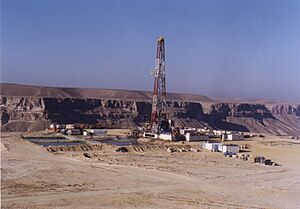
Yemen faces a severe water scarcity. It is the poorest and most water-scarce country in the Arab world. Groundwater levels have dropped dramatically. The civil war has made it even harder to improve water access. Many Yemenis struggle to get enough water for drinking and bathing.
UNICEF and its partners are working to provide safe drinking water to millions of people in Yemen. They are also helping to build better water systems.
People of Yemen
Yemen's population is about 34.7 million people. A large portion of the population is under 15 years old. The population is expected to grow significantly by 2050.
Demographics and Groups
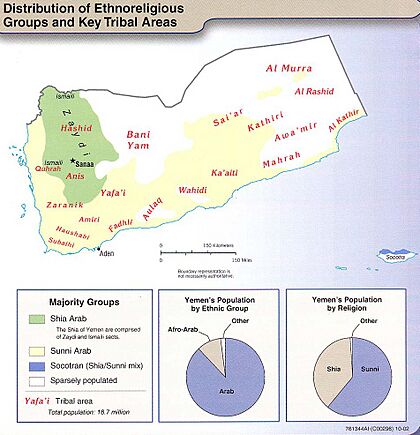
Yemen is largely a tribal society. Most minority groups left when North and South Yemen were formed. There are also people of Indian and Persian origin. Many people of Arab descent in Southeast Asia, East Africa, and India have roots in southern Yemen.
Yemen is considered the birthplace of the Arabs and the Arabic language. Yemen is also a country that hosts refugees, mainly from Somalia, Iraq, and Ethiopia. Many Yemenis have also been displaced within the country due to conflict. A large number of Yemenis live in neighboring Saudi Arabia and the United Kingdom.
Languages Spoken
Modern Standard Arabic is the official language. Yemeni Arabic is the everyday language. In some eastern areas and on Socotra Island, other non-Arabic languages are spoken. English is an important foreign language, especially in the south.
Religion
| Religion in Yemen | ||||
|---|---|---|---|---|
| Sunni Islam | 56.36% | |||
| Zaydi Islam | 42.1% | |||
| Others | 1.54% | |||
Islam is the official religion in Yemen. Most Yemenis are Muslim, divided into two main groups: Sunni (about 53%) and Shia (about 45%). Sunnis are mostly in the south and southeast, while Shias (mainly Zaydis) are in the north and northwest.
There are very small numbers of non-Muslims, including Christians and Jews. Most Yemeni Jews have moved to Israel. Yemen is known for having a very religious population.
Education

In 2010, about 64% of adults in Yemen could read and write. The government aims to reduce illiteracy even further. Education is supposed to be free and compulsory for children aged six to 15, but this is not always enforced.
Yemen has increased its spending on education. There are also projects to improve education, especially for girls in rural areas.
Health Care
While Yemen has tried to improve its health care system, it is still not fully developed. Spending on health care is low compared to other countries in the Middle East. There are few doctors and hospital beds for the population. Health services are especially hard to find in rural areas. Emergency services are often not available.
|
See also
 In Spanish: Yemen para niños
In Spanish: Yemen para niños




